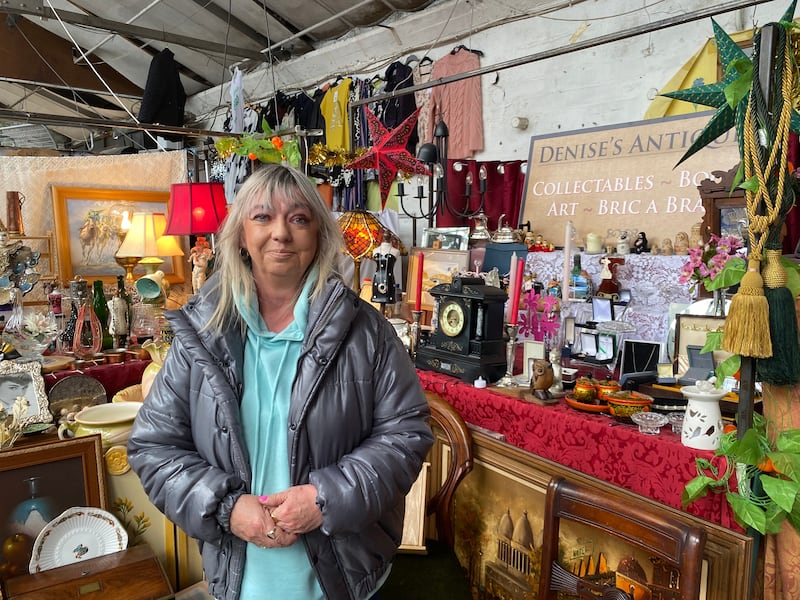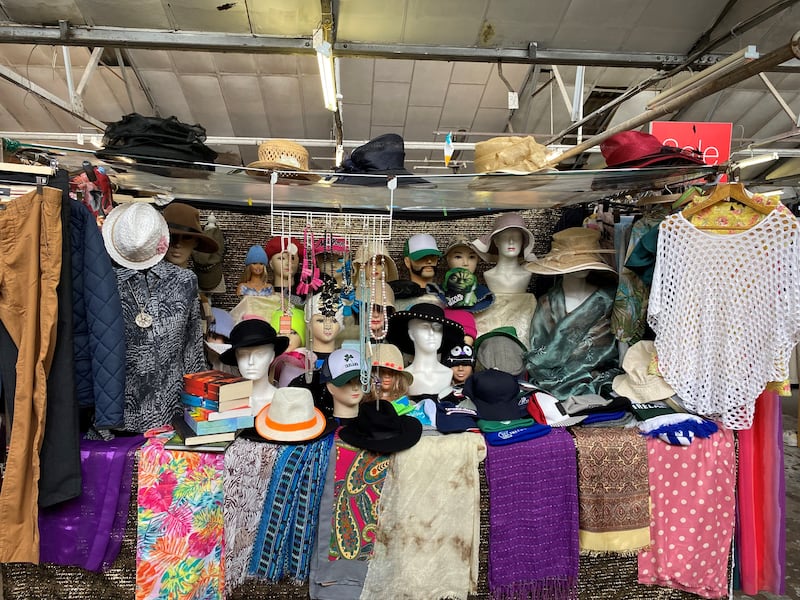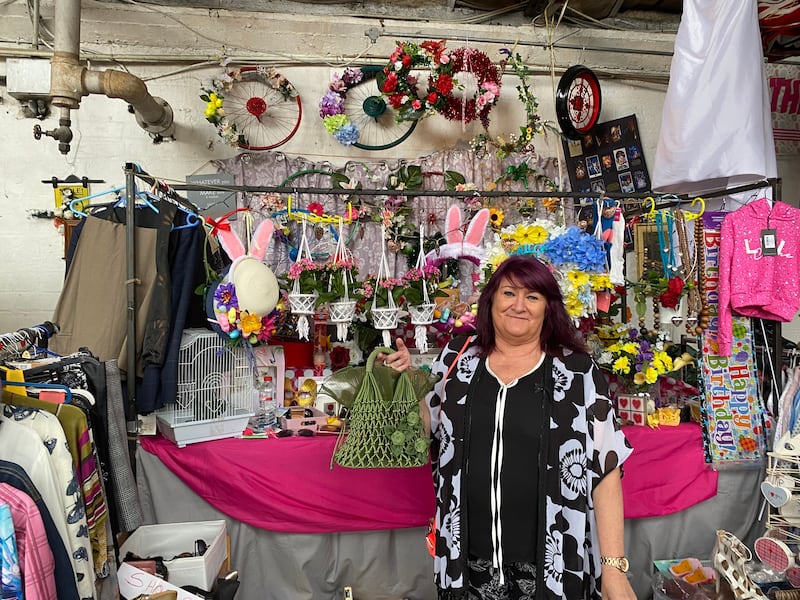For the bargains, the hard-to-find, the one-off treasures, the local crafts; for the serendipitous find or the regular favourite, for the haggle or the deal, for the personal contact with the maker, for the friends’ meet-up and casual chats, for buying direct from a collector or artist or crafter or small start-up, and for making a day of it rather than just a commercial transaction. And for the bargain; did we mention the bargain? For all these reasons and more, we like markets.
Every city needs good markets; they’re part of the life and the commerce, circularity and sociability of the urban ecosystem.
There are some great – mostly food and craft – markets in the Dublin suburbs (from Red Stables at St Anne’s Park, to Dún Laoghaire People’s Park, Lucan’s Urban Market and Blackrock Market), and there are plenty of foodie and “farmers’ markets” further afield, all around the country. But there’s a sense that Dublin city has lost part of its market culture in recent years, to the march of relentless development.
Dublin’s Dandelion market is a distant memory, long swallowed by Stephen’s Green Shopping Centre.
At the Iveagh Market on Francis Street – an Edwardian glory built by the Guinness family, opened as a wet (food) and dry (clothes) market in 1906 and gifted to the city – there is a stand-off between Dublin City Council, private developer Martin Keane who has not developed the site since taking over the lease two decades ago, and the 4th Earl of Iveagh, seeking a reversion of the market because it has not been developed. Meantime, this historic and protected building in the heart of the Liberties has, utterly shamefully, been allowed to decay into dereliction. An ongoing High Court case has been put back until October.
Across the river, the Victorian covered market in Smithfield, formerly the fruit and vegetable emporium dating from 1892, is also empty and idle. Dublin City Council appears to have no urgency to redevelop what could be a glorious food market and linchpin enlivening the north inner city; planning permission was granted in 2015, the fruit market closed in 2019 for redevelopment, but by June 2022 DCC was saying construction “might” begin in 2025 — six years after it closed — and only this month started to look for conservation advice.
The vibrant weekly market at Newmarket in Dublin 8, ranging from brocante to vintage to furniture, was lost to myriad “development” in the area in recent years.
There’s a community of traders interested in long-term, sustainable markets, and customer demand for alternative, more sustainable places to shop and gather
While Dublin city is crying out for a proper, permanent market – and ideally more than one – there are some long-standing markets, alongside fledgling monthlies (some outdoors, so they’re seasonal). It’s a dynamic sector. The latest monthly market on the block started this August at Hen’s Teeth store, gallery and cafe in the Blackpitts, Dublin 8 (first weekend of the month, run by Hen’s Teeth’s Greg Spring and payment provider Square, hensteethstore.com), selling contemporary homeware, lifestyle, streetwear, crafts and jewellery.
As Dublin reawakens after the pandemic, markets are springing up organically in the absence of the city leading the way. There’s a community of traders interested in long-term, sustainable markets, and customer demand for alternative, more sustainable places to shop and gather.
We sampled some over the summer, in areas long associated with markets. For more information on markets of all sorts across Ireland, see collectireland.com/markets.
Jamestown Market, Dublin 8

I run into stall-holder Mags outside this old-school market tucked away in a former industrial unit at the end of a residential street. What do you sell, I wonder? “If you sit on my stall long enough I’ll sell you!” She has second-hand clothes, shoes, electrical. Market customers are locals, and others come by bus, she says. She’s had the stall for years, and says many stall-holders are retired, collecting and selling and enjoying the craic with friends and customers. Many traders hold stuff for people to come back next week, she says. As well as regulars with permanent stands (much easier than setting up and dismantling), others come and go.
Inside there are about 30 stalls, plus a pre-loved electrical shop and another with vinyl, CDs, merch and bicycles. At the entrance, a mannequin wears an academic gown. There are new socks and jocks, some furniture and ornaments. There’s lots of second-hand clothes, basics for adults and children, and root around and you might find a gem; I spy a Donna Karan dress on a hanger. Most items seem great value, and like all markets, haggling is recommended, and part of the experience.
What do you sell, I wonder? ‘If you sit on my stall long enough I’ll sell you!’
One stall is unclassifiable – with good-quality men’s shirts, and laid out on the table, new hairbands, tubs of Bisto, cocktail sticks, CDs of the Royal Showband, tubs of buttons and children’s paint.
Jamestown Market is owned by Clare Doyle. Market supervisor Paula Lee, who also sells clothes, says she kitted herself out at the market for a family communion recently: a Jasper Conran jacket (€3) and shoes (€4), finished by a Gucci scarf from Bridget Maher’s stall. Maher (“I’ll be 85 in November”), in the main hall, sells scarves and hats: from baseball caps and a Star Wars-themed hat to wedding confections.

Among locals who buy at the market are immigrants from Romania or Nigeria, and Travellers. Some are the poorest of the poor, says Peggy, who sells adults and children’s clothes. We look after them with better deals, she says. “Moore Street is gone. I’m a northsider. I used to go there of a Saturday to get my bits and pieces. It was where the bargains were. You’d never be a millionaire here. I enjoy the stall, it gets me out of the house.”
Karen Tierney on the stall across from her agrees that stallholders look after customers down on their luck. She’s selling her crafts: bike wheels threaded with silk flowers and fairy lights, wreaths for occasions or graves, macrame plant baskets. She also sells bric-a-brac, clothes and accessories. She shows me a handcrafted sage-green silk and lace handbag. It cost €25, was used once and she’s selling for €8.

Market regular Denise started selling her collectibles after decluttering last September. She has some lovely small items: costume jewellery, a beautiful Tiffany lamp, a small wooden writing slope, glass and china, and a tea-set. There are great characters at the market, she says. Always haggle, she advises, that’s what markets are all about. She remembers the Dandelion market as a child: “I loved it.”
Lee points out some brand-new communion dresses at another stall, the last of a large consignment from a shop closing, going for €20 each. The daughter of a man who enjoyed the market for years donated his Savile Row shirts to another stall when he died, she relates. She checks out a Dolce & Gabbana handbag beside her, the tag on it still.
Far from everything is designer here, but those with a good eye could find treasures, and haggle for a good deal.
90 Jamestown Rd, Inchicore, Dublin 8, every Saturday and Sunday, 9am-3pm facebook.com/jamestownmarket
We Love Markets Flea at the Digital Hub, Dublin 8
In the grounds of the Digital Hub off Thomas Street in Dublin 8, Emma Brereton and Tara McGuinness of We Love Markets have what they describe as a “curated” market, on the last Sunday of the month, six months of the year.
It’s a warm summer’s day and it’s buzzing. It’s described as a flea market, but has more in the line of crafts and small start-ups than what we think of as flea: there’s vintage clothing and brocante and vinyl, but also new craft businesses, paintings, and very fancy cakes. It’s quite hipster. Artist Seán Hillen reckons it’s a postmodern flea market. For him, the market is the right mix in the right place, and his characterful, pointed collages are selling well. Aoife Hanrahan’s Stencilize stall sells geometric animal prints on clothes and other items, and small terrariums she makes herself. She has a shop in Blackrock Market and sells online. Dublin 8 needed something like this, she says. We’ve all been cooped up. People are supportive, conscious of buying local. Markets are great for getting instant reaction to new designs, she adds.
We want to make this normal. Things are getting lost. The internet is drowning us
— Emma Brereton and Tara McGuinness
Pat Cleary’s Archaism stall is traditional flea territory: a weighing scale with chrome dish, and another with old-fashioned weights, a second World War helmet, and a mandola (larger than a mandolin; he’s selling it for another stall-holder). “I’m more a collector than a seller.”
In the centre of the stalls are picnic tables to sit and chat, and although there isn’t much in the line of food, it’s a nice social space. Three pals are catching up. Teacher Aoife Fleming came earlier with her mother Mary. They both love markets, and went to Newmarket “every single week”, with great memories of bargains over the years. Here the prices may be higher, she reckons. She misses weekly markets. She’s just met up with Lynsey Stuart and Eve Horgan and shows us her purchases: cool orange trousers, still with the tag (€61, reduced to €18), which she bought for a tenner, and a floral tunic dress (€15). She bought the trousers from the woman with the lobster necklace, she tells me. That’ll be Bella Agogo, burlesque performer and belly dancer, who’s selling eclectic clothes, costume jewellery and bunting-style Pride pendants made by a friend, Hannah. She sells “clothes that fit humans. People know what I mean”, from size 6 to 22.
Fussy Galore – aka Nuala Reddy – has a large clothes stall with vintage from 1940s to 1990s, as well as more recent pre-loved, and men’s tweeds. She did Newmarket back in the day, later opening shops in Carlow and Mullingar. “I started in markets at 14,” she says. “They’re a great way to test a business starting out.”
Mendicity has a stall selling wooden window-boxes, candle-holders, doorstops from recycled wooden pallets, and lino-prints. They’re made in their nearby social enterprise daycentre, by people who are homeless or in recovery. Aivars Harcenko from Latvia, on the stall, lives in a hostel. He’s done a barista course and is on the Mendicity CE scheme, hoping to find a home. “This moment is this moment,” he tells me.
Right next door, young milliner Margaret O’Connor has lovely “everyday wear”: handmade headpieces with stitching and sequins, and glamorous turban headgear. It’s her first time here and she’s enjoying feedback on her work.
Brereton and McGuinness, running the show, have been involved in markets and events for years. There are nearly 70 stalls today: local crafters and makers, car-booters, vintage furniture and clothes, some recently graduated artists. As we chat, RTÉ presenter Niall Toner is setting up to play music.
They see markets as great for browsing and for selling face-to-face. This is my Saturday night now, says Brereton (as in her social life post-Covid). It’s part of the circular economy, says McGuinness, keeping it local, where people deal face-to-face, buying things they can see and touch and smell in real time. It involves sustainability, a sense of wellbeing and sociability, they say, as well as giving money back to locals rather than big corporates.
They want to “bring the magic back”. Every other country has markets, people making and selling, says McGuinness. “We want to make this normal. Things are getting lost. The internet is drowning us.”
Thomas Street, Dublin 8: last weekend of the month, 11am-5pm. Plus occasional Dandelion Market at the Well (indoors) 12-5pm. welovemarkets.ie
Zeitgeist Flea Market, Dublin 7
About 2km away, north of the river, is another monthly market. Zeitgeist – Delphine Velut and Richie Hartie, who used to run the brocante at Newmarket – held a flea market on the last Sunday in February, in the grounds of the school. A month later, the Digital Hub market started, perplexingly also on the last Sunday. After a couple of months of clashing dates, Zeitgeist moved to the second Sunday.
Velut is wearing a fabulous red leather jacket she bought at a stall this morning. It’s a sunny day with a good vibe; with about 45 stalls today, this location has ease of access for traders and the public, and scope to grow: there’s space for plenty more stalls. There are some crafts, but this market is more flea, with vintage and preloved clothes, furniture, collectibles, small furniture, bric-a-brac, books, shoes. Zeitgeist ran a carboot for the Stoneybatter Festival, encouraging people to clear their cupboards. There are a lot of locals, and young families. Dublin Digital Radio is playing music, and Velut plans for live gigs.
Celina Anderson and Dee Coogan are sitting in the sun at their joint stall – vintage clothes, jewellery Coogan makes plus vintage brooches, a stuffed toy dog Anderson is reluctant to sell, jigsaws (“all the pieces are there”), and handmade bandanna-dogcollars. Anderson grew up in markets. Her mother Tess Ryan (and her mother before that) had a stall at the Iveagh Market. She supplied theatres with vintage clothes, she tells me. “There are not enough markets, it’s a shame. We need something like Covent Garden in Dublin. Traders want more markets.”
She does this part-time. “I make a living out of it and it subsidises if I want to buy things.” She says market folklore is being researched at DCU, and talks about Sé Merry Doyle’s 2001 documentary, Alive Alive O – A Requiem For Dublin (now free to watch on IFI archive player), which chronicles the lives of Dublin street traders and their daily hustle and bustle. Anderson’s mother, Tess Ryan, sings on it.
“Watching it,” Anderson says, “I was sitting there in tears. It’s been destroyed.” She remembers the architecture, the glass roof, of Iveagh Market. “There were wet and dry areas, and coloured Travellers had stalls on the balcony.” She likes Zeitgeist. “There are lots of locals and people into recycling and upcycling”.
‘All markets are 80 per cent rubbish, and 20 per cent good stuff – and 5 per cent very good’
Across from her, as the market winds up, Liam McKenna is packing what’s left of his eclectic selection of smaller furniture: stools, small tables, cast iron, metal advertising signs, brasswear. McKenna says: “All markets are 80 per cent rubbish, and 20 per cent good stuff – and 5 per cent very good. There are gems everywhere. What people love is the thrill of looking. No one needs stuff when you come to a market!”
He used to have a sign saying: “There’s nothing in here you need. But you better check just in case.”
What gems has he got today? He talks enigmatically about a piece of erotica from Amsterdam. It’s a niche item, he says. Markets are not what they were, but prices in shops are going up and he sees a place for them. He picks up a nicely made hoop-topped stool, that might go for €225 in a fancy shop, but which he’s selling for €75 or €80. “A good market is a mixed market, he says. Car-booters bring a large volume of people to markets; if it’s too niche you won’t get the footfall.”
Geoff Kirk, another market veteran, specialises in mid-century modern furniture, including Danish and Swedish, and glass and ceramics. He travels in Europe, sourcing. It’s a shame there’s not a permanent market in Dublin, he says. “I don’t know another big city without a market. It brings young people in.”
He says markets are great for start-up shops and restaurants to try out their wares. “This market is getting going. It’s good to get out and socialise again after lockdown and meet other dealers. There’s been no opportunity to collect or buy when there was no travel.”
Someone sold a €300 gold ring today, he tells me – the buyer knew what they were looking at. “Lots of other stuff is €5 or €10, stuff that people will take a punt on.”
Educate Together in Stoneybatter, Dublin 7, second Sunday of the month; plus occasional car-boot sales facebook.com/lezeitgeistfleamarket


















